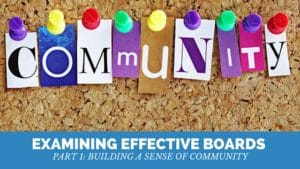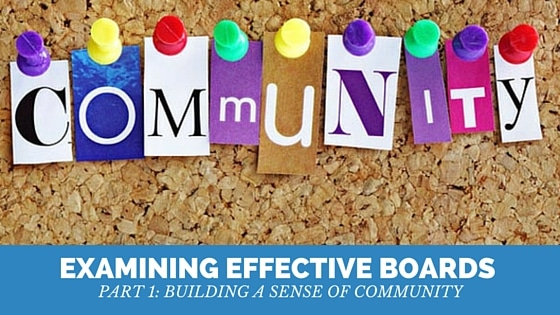 A question and answer session with experienced board member Shiva Berman
A question and answer session with experienced board member Shiva Berman
 For our second guest blog post, we sat down with Shiva Berman, who has served as a nonprofit board member for over 18 years and has held several board leadership roles including board chair, fundraising committee chair, and board development/governance committee chair. She has worked domestically with organizations making an impact in health and human services, education, the environment, and foster care, as well as internationally with UNICEF and governmental organizations. Currently, Shiva advises nonprofit executive directors and board chairs on governance and fundraising issues, primarily around developing and strengthening their leadership, policies, and fundraising practices; growing and ensuring sustainability; and weathering transitions.
For our second guest blog post, we sat down with Shiva Berman, who has served as a nonprofit board member for over 18 years and has held several board leadership roles including board chair, fundraising committee chair, and board development/governance committee chair. She has worked domestically with organizations making an impact in health and human services, education, the environment, and foster care, as well as internationally with UNICEF and governmental organizations. Currently, Shiva advises nonprofit executive directors and board chairs on governance and fundraising issues, primarily around developing and strengthening their leadership, policies, and fundraising practices; growing and ensuring sustainability; and weathering transitions.
Shiva has been a wonderful mentor to me, both personally and professionally. We met 5 years ago when I joined the UC Berkeley Board Fellows Program, which places graduate students on local nonprofit boards. Shiva is brilliant, positive, and gentle, while running an efficient and effective board that gets work done and makes tough decisions. When I have questions about boards, I turn to Shiva.
Shiva is a virtual fount of board knowledge, so we’re breaking her advice up into a series of posts about board effectiveness. We hope you learn as much from her wisdom as I am privileged to!
Q1: What would you say are the characteristics of an effective board?
A1: In my mind, all aspects of board membership and governance are intricately connected. A more meaningful and beneficial way of thinking about effective boards might be to consider the interconnectedness of everyone and everything that happens at the board level: how the board cares for and nurtures its members; how each board member is connected to each other, the organization, and the environment in which it works; the depth and breadth of these connections; how the board addresses conflicts and encourages collaboration; how the board distributes power and responsibility, and much more.
Looking at it from that perspective, an effective board is one that has provided opportunities for the formation of a community with deep and meaningful connections between its members, and between its members and the organization. This is a board with a culture that embraces and nurtures its members and brings out the best in each of them. A culture that has found ways to align the creative talents and the expertise of its members and their environmental connections to serve the needs of the organization, while providing for their sense of well-being and happiness. In such a community, every member is valued for their individuality (the unique expertise and experiences, and viewpoints and mindsets they bring to the board) as well as the role they play in making the community strong.
Such a community needs time and repeated positive interactions to form. In my ideal world, the perceived “soft” aspects of our work, are exactly where an investment of time and energy will pay off. How can anyone expect to know and understand what goes on in the mind of any other board member, if one only sees/hears that person sporadically within the time constraints and space confinements of a short board meeting? Especially if that meeting is totally dedicated to reviewing the financials and dealing with funding issues, as is common to most board meetings?
Thinking of a board as a community of committed and caring individuals, who in turn feel respected and cherished, opens the door for deep perspectives. If I know you and care for you as a person, and am cared for in return, I will have a much easier time relaxing around you, feeling creative together, and understanding where you are coming from. All of this will make it easier and more palatable for me to engage with you, consider your ideas and act upon your guidance.
Thinking of the board as a “community of caring and cared for individuals” who happen to serve together, will give us the opportunity to tap into each member’s natural inclination to step up to get things done exactly because they feel that they are valued and respected members of the community. After all, most of us want to be viewed by those who care about us as contributors and partners.
The strength of this community is a defining factor in how effective the board can be.
Q2: How do you build this community and ensure its effectiveness?
A2: The board community’s needs are much like many other communities. It needs:
- Physical and emotional safety – an inviting place to gather and knowing that one is welcomed, valued and respected for what one brings to the board.
- Access to resources – a supportive and informative staff, not to mention good and nutritious food at its gatherings!
- A structure in which to function – a structuring of roles, responsibilities and expectations, a definition of how it shares power across the body of the board, and an emphasis of what its job is and what it is not.
- Openness and room to breathe and grow – procedures around open discussions, allowing for creative thinking, and educational opportunities where the members as well as the entire board can expand their knowledge base.
- The opportunity to enjoy and de-stress – nothing moves a meeting further and releases tensions faster than a good sense of humor, and an openness to laughter and fun.
- Open communication and an understanding of communication best practices – how the board chooses to conduct its meetings, and how it values the input of each of its members.
- To celebrate and gather around a table together – much the same way as we have all done for centuries to build good cheer and camaraderie.
- To plan for its future and develop resources to achieve that future – strategic thinking around all aspects of the board’s work, and developing ways and means to attract new and committed members fall under this category.
Stay tuned for our upcoming installments of Shiva’s board reflections, in which we take a deeper dive into how to build a supportive board community; how to improve board engagement (especially in fundraising), board committees, changing or expanding board membership, and Shiva’s go-to resources and books on board governance.
What questions do you have about boards? Email sedora@msnmoonsailnorth.kinsta.cloud or ask us on Facebook, Twitter or LinkedIn!


